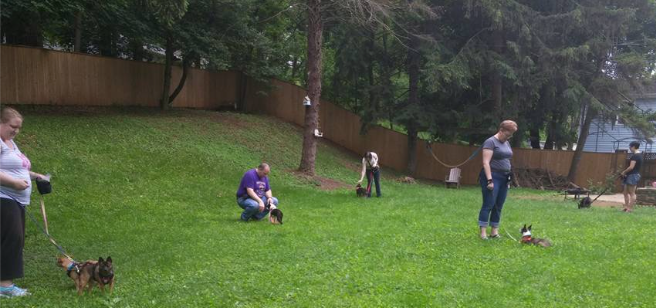I hope you paid attention in science class, because this article is all about DNA and how it affects your dogs’ response to triggers.
Kidding!
Well, sort of. This is all about DNA, but your attention in science class could have been completely absorbed by the cutie one desk over and you’ll still be able to follow.
It’s just that the way to prepare yourself for how well your dog is going to be able to handle things that usually upset them is by remembering D-N-A.
First let’s talk about what I mean when I say “trigger” since it’s a word that gets thrown around a bit these days. A trigger is something that causes an eruption – much like the trigger that causes the gun to fire, or the trigger that causes the spouse to blow up because you’ve left that wet towel on the bed one more time. For your dog, it could be many things – other dogs, kids on skateboards, delivery trucks, or any combination of things. And you may struggle some days to decide if this is the time we need to cross the street and distract with steak, or if we can just hold a sit and eye contact while the trigger passes. And that’s where DNA comes in. Not your dog’s genetic structure – I mean, that certainly affects their behavior, but we can’t change that. Instead I’m talking about:
DISTANCE – how far your dog is from the trigger. This could be physical distance, like across the street or across the park. It could also be volume, like a siren around the corner or a dog barking a long way away. This is often the easiest of these factors for us to adjust; we can move across the street or turn and head in the opposite direction.

NUMBER – how many triggers are being encountered. A dog who is extremely bothered by other dogs may be able to handle seeing one other dog on the street, but will be uncontrollable passing by a busy dog park. Similarly, the encounter doesn’t have to happen all at once. That dog who makes it past one dog with ease may be able to do so again on their walk, but by the time they’ve passed their sixth dog, even if each of these dogs are seen individually, they start to feel like they’re running into six dogs at once. We seldom have much control over how many triggers we encounter.

ACTIVITY – how active are the triggers. A skateboard sitting still won’t get very many dogs worked up. A skateboard rolling down a hill at full speed will definitely get some attention. Perhaps surprisingly, we do have a little control over this, when remember that our own dog’s movement counts as well, so stilling ourselves can help ease some of the excitement.
Asher here is in one of his final sessions of our reactive dog class, so we thought we’d test him while Score played a game of “not fetch”. Asher couldn’t stay this cool his first week – he and his mom did great work!
The trick to using DNA to help you through potential triggers is to remember that if any one of these factors gets more difficult, the other two should get easier for your dog to maintain their level of control. If your dog sees another dog but everyone is holding it together, but another two calm dogs suddenly appear, you’d be wise to give your dog more distance. If those dogs are active, you’d better make it a lot of distance as quickly as you can.
Each individual dog will have specific triggers that bother them more than others, of course, and you’ll need to learn on your own if your dog is bothered by men in hats or yellow dogs or mail trucks. But no matter what the specific thing is, you can take charge and help keep calm by working with DNA, and adjusting the factors you can control in the face of those you can’t.
